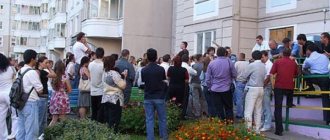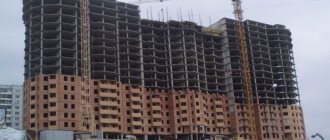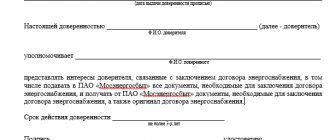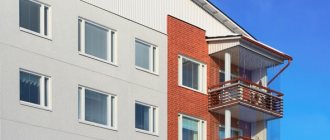According to Art. 16 of the Housing Code of the Russian Federation, residential premises include:
- residential buildings or parts of houses;
- apartments (parts of apartments);
- rooms.
It is interesting that the code does not directly define an apartment building (decoding the abbreviation MKD), apparently for the reason that only apartments are residential in it, and not auxiliary common areas. Since the majority of the population in cities and towns lives in apartment buildings, the life support of which is carried out by various housing and communal services (HCS), the purpose of the article is to understand what MKD in housing and communal services is.
MKD - what is it in housing and communal services: provisions, requirements, maintenance
A residential building (RD), from the point of view of legislation, is an individual separate building, consisting of rooms and additional auxiliary premises. The purpose of a residential building is accommodation, providing for the household and personal needs of the residents.
- An apartment is a separate separate room in an apartment building, also consisting of rooms and utility rooms, the purpose of which is similar to the purpose of a residential building.
- A room is a part of an apartment or railway that is used for people to live in.
Definition of an apartment building
The definition of MKD is contained in the general provisions (clause 6) of the Decree of the Government of the Russian Federation No. 47 of January 28, 2006:
An apartment building (MKD) is a residential building of at least two apartments (or more), with common property, with separate exits from each apartment to common areas or to a land plot adjacent to the house.
It is forbidden to open production workshops in residential premises or use them for other types of activities, for example, religious ones. At the same time, it is possible to use the first floors of apartment buildings for commercial purposes: these cases are stipulated by law.
For entrepreneurship you need:
- transfer the house to the status of non-residential premises;
- comply with safety rules (fire and explosion safety), sanitary and technical standards in the apartment building;
- do not disturb the routine and peace of residents.
Thus, based on clause 26 of the requirements for MKD (Resolution No. 47), noise in the daytime should not exceed 55 dB, and at night - 45 dB.
The auxiliary premises of the apartment building cannot be used for living..
A special interdepartmental commission should monitor the condition of the apartment building. It defines:
- suitability of the apartment building for habitation;
- emergency condition;
- the need for reconstruction or demolition.
The difference between an apartment building and an individual residential building (IDH)
- The wording “individual building” means that the owner of a residential building can be one person or one family.
- There are no common areas in a private house.
- If there are two families in the house, which means at least two apartments, a common territory already appears: this can be a common corridor or courtyard (plot of land), the exits to which are available from each apartment.
Thus, a private two-family house can already be called an apartment building. It is the presence of public premises (common premises) and public property (public property) that is the main distinguishing feature of MKD from IZD.
Common property of an apartment building
Apartments are the property of the residents of the apartment building. A reasonable question: on what principle is the common property of an apartment building divided? The answer is given by Art. 37 Housing Code of the Russian Federation:
The common property of an apartment building is divided according to the principles of shared ownership: each owner of the premises owns a share of the apartment building, proportional to the area of the apartment of which he is the owner.
For example, the total area of the building (GPA*) is 6500 m², the GPA of an apartment is 70 m². The share of the total property of the apartment building of the owner of this apartment is GPC/OPZ = 70/6500 = 0.1 077 = 1.077% of the general property of the apartment building.
Note*: The total area of the building includes the total area of all floors, calculated from the internal surfaces of the external walls of the house (plinths are not taken into account), and the area of open galleries, open loggias, balconies, passages, mezzanines
The OI MKD has several interesting features:
- The share in the right to the common property of an apartment building repeats the fate of the ownership of residential premises: it appears when the right to an apartment arises and is canceled when this right is alienated.
- Despite the presence of a share of the property, it cannot be separated from the entire property of the house (the principle of an indivisible thing).
- The owner of the apartment cannot dispose of his share in the right to common property in the residential apartment building, that is, alienate it to other persons separately from the right of ownership of the residential premises, rent it out for use, rent, etc.
Types of common property of apartment buildings
To the OI MKD, according to Art. 39 of the RF Housing Code and Resolution No. 491, include:
- basements, entrances, corridors, stairs and landings;
- technical floor, roof, attics, gutters;
- external loggias, balconies, terraces, etc.;
- enclosing structures, foundation, floor slabs, facade;
- elevators, garbage chutes, ventilation and shafts for them;
- engineering communications, mechanical and electrical equipment (pipelines, electrical cables, distribution boards, meters);
- the land plot on which the building is located;
- the area adjacent to the house, including sidewalks, entrances, playgrounds, green spaces, etc.
Maintenance of apartment buildings and common property of the house
The maintenance of apartment buildings and care for the safety of common property can be carried out:
- directly by the residents themselves (if there are no more than 30 apartments in the apartment building);
- housing and real estate ownership partnerships (TSN and HOA);
- Housing cooperative (housing and construction cooperative);
- management company.
Mkd uk Chernigovskaya in the receipt for the communal apartment where it is located
The first part of the receipt for housing and communal services includes information about the details of the company providing the services; they are needed so that the user can pay for utilities.
Interesting read: How to register a garden house in SNT
- The second block contains general information about the utility consumer (the owner or tenant of the residential premises), as well as the number of people living or registered in the apartment.
- The third block is the most important.
- maintenance of structural parts of the building and in-house engineering equipment;
- cleaning and maintaining order in the area adjacent to the house;
- maintenance of indoor gas equipment;
- disinsection and deratization (fighting insects and rodents);
- landscaping of the yard and adjacent areas;
- bringing public places into proper shape;
- timely garbage removal;
- maintenance of ventilation ducts and chimneys;
- elevator maintenance (if there is one in the apartment building);
- maintenance of the garbage chute (if there is one in the apartment building);
- electric lighting of common areas.
MKD - what is it in housing and communal services: getting acquainted with the terminology
Living in an apartment building, few people know its distinctive features and characteristics. We invite you to get acquainted with the definition of these buildings from a legal point of view.
MKD has its own definition
MKD - what is it, according to the Housing Code of the Russian Federation
First, it’s worth understanding the terminology. This concept is disclosed in Article 16 of the Housing Code of the Russian Federation, according to which, an apartment building is an individually defined building, consisting of rooms and auxiliary premises, the main purpose of which is to satisfy the domestic and other needs of citizens living in this building. Its signs include:
- structural elements;
- separate area;
- systems that provide certain amenities for citizens living in the building, for example, water supply, heating and others.
The apartment building is located on a separate plot
Main characteristics of an apartment building
The characteristics of a particular MKD are specified in its technical passport. It is compiled for each building separately in the BTI. During the operation of an apartment building, this document is periodically updated. It states:
- total area of the building;
- square footage of a specific apartment;
- area of non-residential sector facilities.
The house passport contains all the necessary information
Attention! The characteristics of an apartment building are important when changing the owner of a building and allocating funds for its maintenance.
The amount allocated for maintenance depends on the characteristics of the house
What is the difference between an apartment building and a private house: main points
A private house is essentially an apartment equipped with a separate entrance and several living rooms. As a rule, it has one owner. It is possible to have several co-owners, each of whom owns a certain share, and they can only have rights in parts. If there are at least two full-fledged owners, we are already talking about an apartment building.
There are more than two owners in the apartment building
MKD assumes the presence of several apartments, each of which has its own owner. The house is managed either by the management company or the council. In an apartment building there is common property, in a private one everything belongs to the owner. All issues related to the management of common property are resolved at meetings.
Attention! An apartment building built on a plot for private construction will be demolished.
A special area is allocated for MKD
New line on the receipt
Specialists of MKU Housing and Communal Services note that the presence of the line “Management of MKD” in receipts of management organizations is not provided for by law, referring to Federal Law-176, Article 1, paragraph 13a, which requires “in Article 154, paragraph 2 of part 1 of the Housing Code of the Russian Federation, to be stated in the following wording: “payment for the maintenance of residential premises, including fees for services, work on managing an apartment building, for the maintenance and current repairs of common property in an apartment building, for cold water, hot water, electrical energy, thermal energy consumed in the maintenance of common property in apartment building, as well as for the disposal of wastewater for the maintenance of common property in the apartment building. Major repairs of common property in an apartment building are carried out at the expense of the owner of the housing stock.”
The management company is obliged to submit its proposal for the necessary measures for each column in monetary terms. All work must be regulated in the form of estimates or an inventory of work. For the consumer, everything should be transparent not only in the inventory, but also in volumes and in monetary terms. The total amount gives the figure in this column. The management company presents its proposal, the general meeting considers it and makes a decision. It is the owners of the premises who approve the final cost. When the owners, having received a receipt, are at a loss regarding the new lines and amounts, this indicates that the general procedure for approving the cost of the management company’s services was violated: the list of all services was not discussed by the owners, most owners do not know how the fee for maintaining the common MKD property.
- Premises that make up the residential sector - apartments in residential buildings and rooms in dormitories. May be owned by individuals, legal entities, private individuals or government companies.
- Non-residential sector located on the first or ground floors of buildings. Is owned by legal entities or individuals.
- Areas for other purposes that are not apartments. These are common hallways, stairwells, attics and basements, and elevators.
- House controls. In an apartment building this is the management company, in a private building it is the owner of the house.
- Residential building management. In an apartment building, all issues are resolved by the meeting, and in a private house - by the owner.
- Availability of owner.
- Components of a residential building. In an apartment building these are apartments, in a residential building these are rooms.
- Shared ownership of common property. In an apartment building there is shared ownership, in a private house there is no.
What premises are included in an apartment building: interesting nuances
According to the Housing Code, the MKD includes:
- residential sector, including individual apartments owned by the state, legal entities and individuals;
- non-residential sector, located on the first or ground floor. Its owner can be either individuals or legal entities;
- other areas not included in the apartments. This includes common corridors, attic, basement, elevator, stairs, the so-called common property.
MKD includes different sectors
Decoding of utility bills for housing and communal services, which is included in the rent receipt
- about the payer and recipient of payment for housing and communal services (full name, name of organization, TIN, bank details, personal account number);
- information about the residential premises (area of the apartment, the house as a whole, address, number of residents);
- calculation of payments for each type of services provided;
- reference Information.
What is included in the ODN according to current legislation? In fact, we are talking about the costs of maintaining the common property of the house. And it includes cleaning of entrances, their lighting and heating, elevator maintenance and other measures to maintain its normal condition.
How tariffs for the maintenance of an apartment building are determined: procedure and features
Tariffs are set annually at a meeting of homeowners. Citizens living in apartments belonging to municipal or state property are present at the meeting, but do not take part in voting. They additionally pay a fee in accordance with the social rental agreement. An agreement is concluded between the management company and the owners, which provides:
- list of services to be provided;
- the cost of a specific type of work;
- payment terms and procedure;
- restrictions on the provision of services in the event of debt.
Attention! In the absence of an agreement, invoices issued may not be paid.
Tariffs are formed in four areas:
- Maintenance;
- maintenance of common areas;
- major repairs;
- social hiring.
Tariffs are set at the meeting
What do we pay for in the column “Management of apartment buildings”?
The management fee for apartment buildings (MKD) is charged by the management company. This is the only line of the receipt from which funds are sent to the accounts of the management company or other management organization. In essence, this is payment for services provided by the company to the residents of the house.
“MKD management” includes not only work in the house and yard. This also includes administrative functions. All this is described in detail in the agreement that the management company concludes with residents. The cost of all services must also be specified there.
Most often, receipts separate the concepts of “MKD management” and “maintenance and current repair of MKD”. The second is more understandable for residents - it includes all seasonal work in the house, for example, patching the roof, repairing facades or cosmetic work in the entrances. This also includes street lighting, garbage removal, and cleaning of entrances. We talked about this in more detail in the article “What is included in the maintenance of the common property of an apartment building.”
But besides this, the Criminal Code carries out a lot of administrative work. This, as a rule, requires a serious staff of specialists in various fields.
By “MCD management” we mean the following:
- storing technical documents for houses, making changes to them as necessary;
- preparation of papers for work with contractors, if they will be carried out on the territory of the house;
- work with resource suppliers: water, electricity, heating. The management company enters into contracts with them and is the executor of the utility service - it accepts payments and sends them to the account of the resource company;
- working with residents’ payments also involves working with debtors, including collection of debt in court by company lawyers;
- quality control of provided public services;
- passport office: registration of citizens, registration at the place of residence, issuance of certificates;
- Dispatching service;
- providing information on major repairs, supervising the contractor’s work;
- disclosure of information to owners, filling in the GIS housing and communal services system with information.
Information work with residents is added to this rather large list. For example, the management company is obliged to notify owners about changes in tariffs or talk about the possibilities of special accounts for major repairs.
MSW - what is it in housing and communal services, and who is responsible for providing public services
First, let’s figure out what MSW is in housing and communal services. This is a public service provided to all residents of an apartment building for the collection, removal, neutralization and disposal of solid household waste. Let's look at this in more detail.
MSW – utility service
What rules govern the management of MSW: nuances
Each region appoints its own operator to ensure the management of MSW, and sets uniform tariffs for removal and processing. Rules for handling MSW include:
- the procedure for storing waste by residents;
- operator's responsibilities for handling and procedure if more than 1 m³ of waste is found in the wrong place;
- responsibilities of the land owner in the presence of an unauthorized waste collection site;
- procedure for collecting old electrical equipment;
- standards for garbage trucks;
- rules for processing, recycling, neutralization and disposal of waste, as well as the procedure for drawing up an agreement;
- reasons for deprivation of operator status and obligations of a legal entity after loss of status.
MSW handling is performed by the operator
Payment for MSW in the utility bill
The fee for MSW is billed depending on the number of people living in the apartment. When developing the standard, the average volume of waste generated by one person is taken into account. Each region has its own tariff, depending on:
- volume and number of installed containers;
- the presence or absence of sorting with the possibility of storing various types of waste. In this case, the tariff is much lower;
- a large percentage of waste that can be recycled.
Housing and communal services expenses
Housing and communal services is a diversified system that covers about 30 different types of activities. Housing and communal services are divided into several large sub-sectors:
- housing;
- providing consumers with resources;
- improvement of cities, towns and villages.
Financial resources of housing and communal services enterprises are formed from financial resources coming from the budget and consumers. The improvement of settlements is financed from the budget, and the provision of consumers with resources is financed from consumer funds.
Housing and communal services enterprises ensure the delivery of utility resources to consumers. Housing and communal services enterprises ensure that utility resources of the required quality are delivered to consumers. The service fee includes payment for:
- cold and hot water supply supplied to the consumer through a pipeline network;
- drainage of household waste using sewer networks;
- electricity supplied to the consumer in the required volume;
- gas supply – round-the-clock provision of gas of the required quality;
- heating - maintaining air temperature in apartments, within the framework of the relevant governing documents.
Tariffs for housing and communal services may vary depending on the region, since they are regulated by local municipal authorities. Housing and communal services enterprises do not have the right to inflate housing and communal services tariffs above those established in the region.
What is the council of an apartment building: you need to know this
Many issues are resolved at the MKD council. Let's find out what tasks he must solve, what functions he must perform, as well as what responsibilities and rights the chairman of an apartment building has.
The Council resolves all issues related to the management of apartment buildings
Main tasks and functions
The main functions of the MKD council include:
- ensuring the implementation of decisions made at the meeting of owners;
- initiation of a meeting at which various issues will be discussed;
- compliance with the procedure for holding a general meeting of owners;
- preparation of a project that will be submitted to a meeting of owners;
- making proposals on the procedure for using, maintaining and repairing common property;
- discussion of draft management agreements concluded between home owners and the management company;
- providing methodological and informational assistance to home owners.
Attention! The Council is elected for a maximum of 2 years. If it has not yet been formed, the local government body must initiate its creation.
Rights and responsibilities of the chairman of the MKD
The meeting is headed by the chairman of the MKD. His rights and responsibilities are quite broad. He:
- meets with representatives of the management company to agree on the draft agreement and make changes in accordance with the wishes of the homeowners;
- announces the terms of the agreement to the meeting of owners;
- concludes an agreement if such powers have been transferred to him;
- controls the work performed by the management company, signs the certificate of completion of work;
- takes part in court hearings on the basis of a power of attorney issued by the owners.
The Chairman can do a lot
The main right of the chairman of the MKD can be called management of the council. If desired, he can refuse to cooperate with the management company in favor of creating an HOA. We hope that the information provided is relevant to you. Share in the comments whether the council works in your home and how effective its work is.
Construction in Russia is the most widespread and at the same time profitable field of activity. The most popular type of construction is considered to be the construction of apartment buildings. The latter variety is most common in megacities.
Dear readers! The article talks about typical ways to resolve legal issues, but each case is individual. If you want to find out how to solve your particular problem , contact a consultant:
+7 (Saint Petersburg)
APPLICATIONS AND CALLS ARE ACCEPTED 24/7 and 7 days a week.
It's fast and FREE !
At the same time, not everyone understands what is hidden under the terminology of an apartment building and what is special about it.
V. Types of apartment buildings (historical excursion)
An insula, or apartment building in ancient Rome, designed for rental. Typically, the lower floors in such housing were given over to shops, and the upper floors to housing. At the same time, wealthy tenants rented individual houses.
Historically, the apartment building as a type of housing arose before our era. According to their functional purpose, the following types of apartment buildings have been formed:
▪ Apartment building. The oldest type of apartment building, intended for long-term rent to third-party residents for permanent residence. This is how it differs from a hotel. In modern Russia, such apartment buildings practically do not exist; real estate investors prefer not to build rental housing, but to buy apartments in several buildings at once, without putting their eggs in one basket. One of the reasons, one must think, is that it is easier to hide from the tax inspectorate.
▪ Departmental housing - real estate issued by private departments or the state to their employees. This type of apartment building arose several centuries ago; back in Tsarist Russia, there were various government apartments for military personnel and officials.
▪ Social housing. Housing for the poor who are unable to either rent or purchase real estate. Abroad, it is usually built by municipalities and issued to those in need of improved housing conditions. In our country, practically no one is building it, because, one must think, unlike the decaying West, Russia is the richest country. Therefore, the fact that in the Rostov region low-income people will have to wait sixty years is a mere trifle.
▪ “House-condominium”. From the point of view of management efficiency, the worst option is an apartment building, since the number of owners of such an object is measured in tens and even hundreds of people. The emergence of this type of housing in Russia began in the middle of the 20th century, when the state began to develop the institution of housing construction cooperatives. The subsequent privatization of real estate turned almost all apartment buildings into similar “collective farms,” and in the meantime, gangster capitalism developed in full force in the country, under which the collective farm as a form of ownership was doomed.
As you can see, an apartment building is both a property and an engineering term. It seems that the main reason for the terribly confused legislation “on the topic of MKD” may be the fact that State Duma deputies, due to limited intelligence, over the years have not been able to comprehend this and, as they say, clearly separate “flies from cutlets” in the legislative waste paper produced.
MKD: what is it in housing and communal services?
The terminology regarding a residential building is disclosed in detail in Art. 16 Housing Code of the Russian Federation. In particular, it means a building that is used for the purpose of living and serving household needs. At the same time, there is no distinction between whether it is a private house building or an apartment building.
Difference from a residential building
A house for one owner differs from an MKD in the following ways:
- Sole owner. There is a nuance in this situation: there may be several owners, but the house building itself with the adjacent plot of land may belong to them as shared ownership. In other words, a private house belongs to the category of indivisible, and each owner will have rights to it only in parts. Based on this, a house for two owners is considered multi-apartment.
- A private building is recognized as a single apartment - a room that is used for living, has a separate entrance, and also consists of several living rooms. There are several or more apartments in the MKD.
- The MKD is managed by a management company or the House Council, and the private building is owned by one owner.
- In apartment buildings, common property is provided, but in a private building it is absent. This sign is considered key.
You need to know that classifying a house as an apartment building or a private building is a key issue. If an apartment building is erected on a site that is intended for a private house, it is subject to demolition.
For this reason, if there are private houses near the new building in which you want to buy an apartment, then you should ask the seller what kind of construction the land is intended for. If possible, we recommend that you familiarize yourself with all necessary documentation.
How to pay for utilities through State Services? See here.
What is MKD in housing and communal services in accordance with the law and its status in housing and communal services
Therefore, if there are only private houses around the new building in which you are going to buy an apartment, ask the developer about the documents for allocating land for construction, and if you discover the above-mentioned fact, refuse to buy - the house will probably be demolished.
You will receive more information when you read the article “Yard, entrance and...”. If the form of management of common property is chosen to be a Home Owners Association or a House Council with direct management, then the apartment owners themselves will manage and maintain it.
General questions about MKD
Owners of apartment buildings are often not always aware of problems that directly affect the common property of the building and the formation of a homeowners association.
This is due to the fact that many issues have not yet been resolved; in particular, many do not know what common property entails.
According to Russian legislation, this category usually includes:
- corridors, attics, basements and so on;
- load-bearing and other types of structures - foundations, slabs, etc.;
- roof;
- electrical, mechanical and other equipment that is being maintained in the MKD;
- the plot of land on which the house is located.
In the case of the formation of a HOA for the purpose of organizing the management of the structure, the house remains in shared ownership.
Major renovation
Back in 2014, modern approaches to the legal regulation of relations gained legal force. From this period, owners are required to pay a fee for major repairs of common areas.
In other words, major repairs in an apartment building are considered mandatory.
According to the Government of the Russian Federation, completed payments make it possible to launch a collective type of investment procedure.
Thanks to this, the housing and communal services sector has the opportunity to develop in the required direction, and repair work will be carried out under the strict control of the relevant authorities.
Housing maintenance
The definition of maintaining an apartment in an apartment building means a set of actions that are aimed at maintaining the property in proper form:
- carrying out major repairs, including current ones;
- compliance with measures aimed at correcting various malfunctions.
According to Russian legislation, housing maintenance includes:
- conducting inspections by companies that are directly responsible for the life and health of residents;
- organization of measures to ensure public lighting;
- carrying out sanitary, cleaning and other measures in common areas with the adjacent territory;
- guaranteed provision of the required temperature conditions within established standards;
- organizing waste removal (liquid and dry) for owners of residential premises and companies located in an apartment building;
- fulfillment of assumed seasonal obligations for the maintenance of local areas.
This list of services is the key one provided by the management company.
At the same time, the management company necessarily undertakes the following types of work:
- carrying out repair work on roofs, gutters and attics;
- work that is necessary to strengthen the facades of the structure, as well as: removal of decorative elements, tiles, bricks, and so on;
- treating trees with antiseptic;
- sealing seams, strengthening hatches and other things.
It is necessary to pay attention to the fact that the management company, together with the residents, have the right to include additional conditions in the contract that do not contradict Russian legislation.
The decision to include additional conditions must be made exclusively at the general meeting. If both parties reach agreement, new adjustments will be included in the agreement and supported by appropriate signatures.
How to pay housing and communal services using a personal account? Information here.
Who can receive a subsidy for housing and communal services? Details in this article.
What is an apartment building (MKD) in the housing and communal services sector: deciphering the concept
The lion's share of all housing is represented by multi-apartment residential buildings (hereinafter - MKD).
The legislator reveals the meaning of this term - an apartment building should be understood as a set of two or more apartments, each of which has its own access to a plot of land adjacent to such a house, or to a common area. The Housing Code of the Russian Federation defines a residential building as an individually defined building, consisting of rooms and non-residential premises for auxiliary use to meet domestic needs.
The concept of a multi-apartment residential building is contained in the legislation
Often the concepts of apartment building and residential building are identified with each other. This should not be done under any circumstances, because there are a number of differences between these types of residential premises.
- number of owners - in simple terms, a residential building has one owner (a residential building can be in shared ownership of several or one owner, but the object of ownership is the building itself), and in an apartment building there are several of them. This means that in a residential building each owner will have a certain share, which will not be specified and cannot be allocated in kind. As for apartment houses, it is impossible to register part of the house as a property, but only a separate apartment with a certain floor, number, area, which will be indicated in the title documents;
- the presence of common premises (which are common shared property) - these are contained only in apartment buildings and have several varieties;
- in a residential building, the owner independently decides management issues; in an apartment building, this is done by a decision of a meeting of all owners, who can resolve current issues by creating an HOA (homeowners' association), or by voting to select a management company.
Many equate the concepts of “residential building” and “mkd”. The definition of the first term is clearly given in Article 16 of the Civil Code of the Russian Federation. According to the code, a residential building is considered an individually defined building, consisting of rooms and non-residential premises for auxiliary use to satisfy domestic needs.
In 2014, completely new approaches to the legal regulation of relations came into force. Recently, owners have been required to pay a contribution for major repairs of the common property of the house.
That is, a major overhaul of the apartment building will become a mandatory event. At least that's what supporters of the proposed reform think. In their opinion, the money paid by the residents will launch the so-called collective investment mechanism.
- regular inspections of the condition of the housing stock and common property,
- maintaining temperature conditions in apartments and common areas,
- Carrying out waste removal, sanitizing public areas,
- maintenance of the local area (snow removal, garbage collection, landscaping, crowning trees and shrubs, lighting, etc.).
Owners of apartments in apartment buildings are given the opportunity to choose where to accumulate these funds: on the account of a regional operator or their own account, opened only for their home.
They can decide at the general meeting and submit the minutes to the management company. The capital repair program, indicating specific houses and a list of planned repairs, is publicly available.
Formation of tariffs
Every year, tariffs are set at a general meeting of residential property owners. If a citizen lives in a municipal or state apartment, then in addition to major repairs and maintenance, the tariff includes payment for real estate, which is provided under the rights of a social tenancy agreement.
Residents of such premises cannot receive receipts for payment for major repairs, since the burden of maintaining the premises rests entirely with the owner, represented by the state or municipality.
The tariff in 2020 is formed in several areas:
- payment for housing under a social rental agreement;
- payment for current repairs;
- payment for the maintenance of common premises;
- payment for major repairs.
It must be remembered that if a fee for, for example, cleaning stairwells is highlighted in the receipt as a separate item, it is considered a violation, since this provision is already automatically included in the item of maintenance costs. In other words, this is an attempt to charge double fees from residents.
Payment by receipt
When monthly receipts for utility bills arrive, not all, but many residents carefully study the amounts of bills and the columns for which payments are calculated. Receipts began to be studied especially carefully due to the constant increase in the cost of utilities.
If the “Gas supply” column, for example, does not raise questions, then the “House maintenance” column may not be clear to everyone. What do consumers pay for under such a column? The service includes many important works:
- This is cleaning common areas.
- Garbage removal and local area cleaning.
- In winter – snow removal and removal.
- Regular maintenance of an apartment building.
- Maintenance.
- Also paid in this column is lighting of common areas, hot and cold water supply to common areas.
- If the house has a concierge, his services are also paid under the “House Maintenance” item.
Services should be provided only those provided for in the agreement between the apartment owners and the Management Company.
ATTENTION! The management company does not have the right to charge payment for services not provided or services of poor quality.
If a service organization performs work to maintain apartment buildings at a low level, residents have the right to complain about it to the Housing Inspectorate, and Rospotrebnadzor, to the prosecutor's office and even to the court.
In the video about the agreement with housing and communal services for the maintenance of apartment buildings
- Due to frequent changes in legislation, information sometimes becomes outdated faster than we can update it on the website.
- All cases are very individual and depend on many factors. Basic information does not guarantee a solution to your specific problems.
That's why FREE expert consultants work for you around the clock!
- via the form (below), or via online chat
- Call the hotline:
- Moscow and the Region
- St. Petersburg and region
- Regions
APPLICATIONS AND CALLS ARE ACCEPTED 24/7 and 7 days a week.








